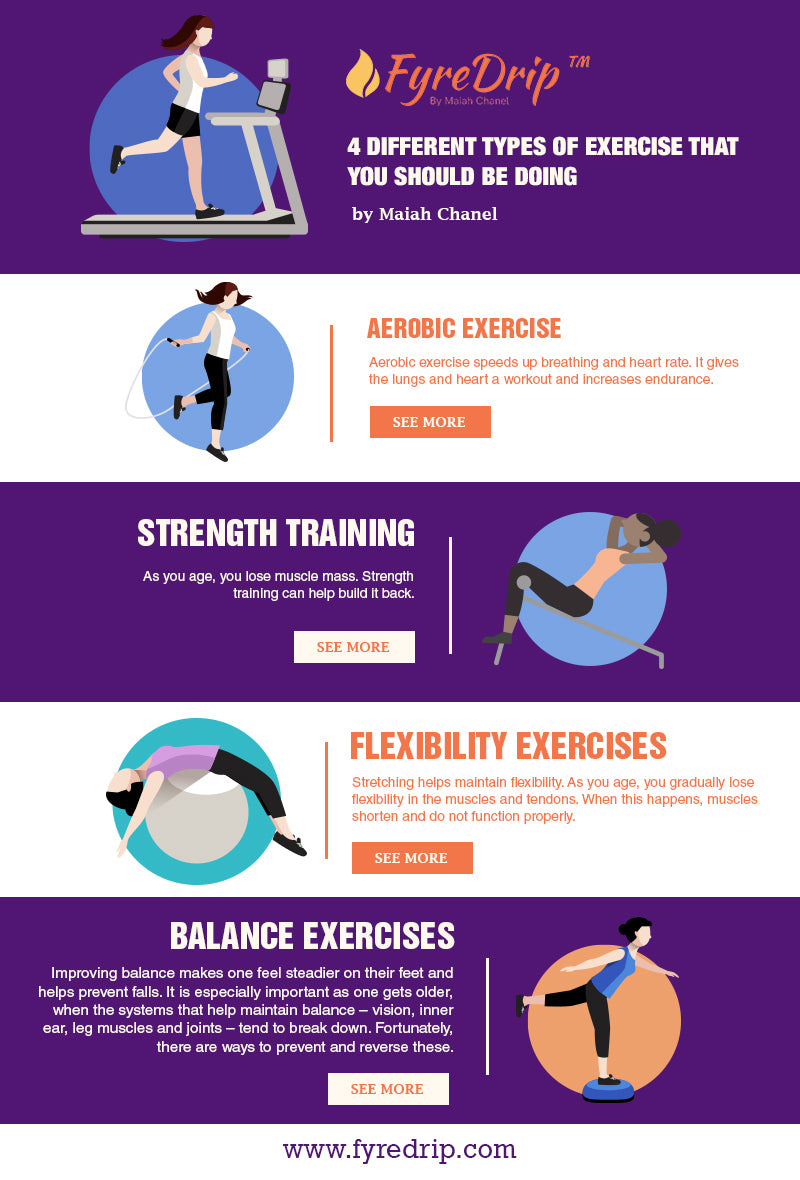
4 Different Types of Exercise That You Should Be Doing
Share
Regular exercise provides many health benefits. It boosts energy, improves mood, promotes better sleep, reduces the risk of chronic diseases, and helps you achieve a healthy weight. To put it simply, exercise is key to good health. In this article, we will educate you about the different types of exercise.
Different Types of Exercise
1. Aerobic exercise
Aerobic exercise speeds up breathing and heart rate. It gives the lungs and heart a workout and increases endurance. If you are too winded to walk up a flight of stairs, that is an indication that you need more aerobic exercise to condition your lungs and heart, and get enough blood to muscles to help them work efficiently.
In addition, aerobic exercise can help lower blood pressure, burn body fat, reduce blood sugar levels, boost mood, and raise good cholesterol (HDL). Combined with weight loss, it can lower bad cholesterol (LDL) levels too. Over the long term, this type of exercise can help reduce your risk of type 2 diabetes, heart disease, stroke, depression, breast and colon cancer.
Aim for 150 minutes of moderate intensity activities per week. The following are some examples of aerobic exercise:
• Brisk walking
• Cycling
• Jogging
• Swimming
• Dancing
2. Strength training
As you age, you lose muscle mass. Strength training can help build it back. When you do strength training regularly, daily tasks such as carrying groceries and lifting heavy objects will be so much easier.
Aside from strengthening your muscles, this type of exercise also stimulates bone growth, reduces stress in the lower back and joints, improves balance and posture, and helps with weight control. It is normal to feel some muscle fatigue after doing this type of exercise.
Here are some example of strength exercises:
• Lifting free weights (barbells or dumbbells)
• Using resistance bands
• Using a resistance/weight machine
3. Flexibility exercises
Stretching helps maintain flexibility. As you age, you gradually lose flexibility in the muscles and tendons. When this happens, muscles shorten and do not function properly. This increases the risk of muscle cramps, muscle damage, strains, and joint pain. Stretching your muscles makes them longer and more flexible, increasing your range of motion, reducing pain, and lowering the risk for injury.
Aim for a program of stretching at least three times per week. Warm up your muscles first, with a few minutes of dynamic stretches (repetitive motion like marching in place or arm circles). It allows blood and oxygen to reach your muscles. Then, perform static stretches (holding a position for up to 60 seconds) for the calves, hamstrings, hip flexors, quadriceps, shoulder muscles, as well as for the neck and lower back.
Don’t push a stretch into the painful range. It is counterproductive and tightens muscles. The following are examples of flexibility exercises:
• Stretching
• Pilates
• Yoga
4. Balance exercises
Improving balance makes one feel steadier on their feet and helps prevent falls. It is especially important as one gets older, when the systems that help maintain balance – vision, inner ear, leg muscles and joints – tend to break down. Fortunately, there are ways to prevent and reverse these.
It is never too early to start balance exercises, even if you feel you don't have a problem with your balance. You can also consult a physical therapist or a gym instructor who can recommend specific exercises to target areas of weakness. Here are some examples of balance exercises:
• Tai chi
• Standing on one foot
• Heel to toe walk
Conclusion
Most people tend to limit themselves to 1 or 2 types of activity. But to get the full benefits of exercise, you should do aerobics, strength training, flexibility, and balance exercises. These different types of exercise will keep you active, healthy, and feeling great.
Stay FYRE!?
Maiah Chanel
